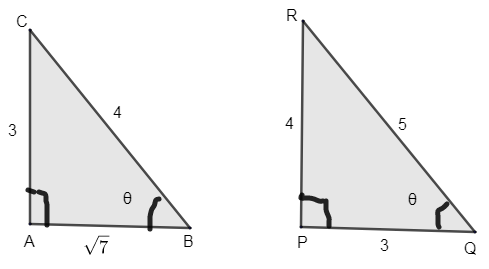
If \[12{{\cot }^{2}}\theta -31\cos ec+32=0\], then value of \[\sin \theta \] is,
(a) \[\dfrac{3}{5}\]or 1
(b) \[\dfrac{2}{3}\]or \[\dfrac{-2}{3}\]
(c) \[\dfrac{4}{5}\]or \[\dfrac{3}{4}\]
(d) \[\pm \dfrac{1}{2}\]
Answer
606.9k+ views
Hint: Substitute the trigonometric formula for \[{{\cot }^{2}}\theta \]. The entire equation becomes in terms of \[\cos ec\theta \]. Solve the equation formed and find the roots. \[\sin \theta \] is the inverse of \[\cos ec\theta \]. Find the root and inverse it to get the value of \[\sin \theta \].
Complete step-by-step answer:
Given the expression, \[12{{\cot }^{2}}\theta -31\cos ec+32=0-(1)\]
We know the trigonometric expression,
\[\begin{align}
& \cos e{{c}^{2}}\theta -{{\cot }^{2}}\theta =1 \\
& \Rightarrow {{\cot }^{2}}\theta =\cos e{{c}^{2}}\theta -1 \\
\end{align}\]
Substitute the value of \[{{\cot }^{2}}\theta \]in equation (1),
\[\begin{align}
& 12{{\cot }^{2}}\theta -31\cos e{{c}^{2}}\theta +32=0 \\
& 12\left( \cos e{{c}^{2}}\theta -1 \right)-31\cos ec\theta +32=0 \\
\end{align}\]
Opening the bracket and simplifying it,
\[\begin{align}
& 12\cos e{{c}^{2}}\theta -12-31\cos ec\theta +32=0 \\
& 12\cos e{{c}^{2}}\theta -31\cos ec\theta +20=0-(2) \\
\end{align}\]
Now, equation (2) is in the form of a quadratic equation. We know a general quadratic equation is of the form \[a{{x}^{2}}+bx+c=0\]. Comparing both the general equation (1) and equation (2), we get,
\[a=12,b=-31,c=20\]
Now substitute these values in the quadratic form \[\dfrac{-b\pm \sqrt{{{b}^{2}}-4ac}}{2a}\]to get the roots.
\[\begin{align}
& =\dfrac{-\left( -31 \right)\pm \sqrt{{{\left( -31 \right)}^{2}}-4\times 12\times 20}}{2\times 12} \\
& =\dfrac{31\pm \sqrt{961-960}}{24}=\dfrac{31\pm \sqrt{1}}{24} \\
& =\dfrac{31\pm 1}{24} \\
\end{align}\]
\[\therefore \]We get the roots as \[\left( \dfrac{31+1}{24} \right)\]and \[\left( \dfrac{31-1}{24} \right)\]\[=\dfrac{32}{24}\]and \[\dfrac{30}{24}\].
\[\therefore \]The roots are \[\dfrac{4}{3}\]and \[\dfrac{5}{4}\].
\[\therefore \]\[\cos ec\theta =\dfrac{4}{3}\]and \[\cos ec\theta =\dfrac{5}{4}\].
We know, \[\sin \theta =\dfrac{1}{\cos ec\theta }\]
\[\therefore \sin \theta =\dfrac{1}{\dfrac{4}{3}}\]or \[\dfrac{1}{\dfrac{5}{4}}\].
\[\sin \theta =\dfrac{3}{4}\]or \[\dfrac{4}{5}\].
Hence, option (c) is correct.
Note: We got the value of \[\sin \theta =\dfrac{3}{4}\]or \[\dfrac{4}{5}\].
Hence, we can find the value of \[\cos \theta \] and \[\tan \theta \].
\[\sin \theta \] = opposite side/ Hypotenuse.
By Pythagoras theorem,

\[A{{B}^{2}}+A{{C}^{2}}=B{{C}^{2}}\Rightarrow AB=\sqrt{B{{C}^{2}}-A{{C}^{2}}}=\sqrt{{{4}^{2}}-{{3}^{2}}}\]
\[AB=\sqrt{16-9}=\sqrt{7}\]
\[P{{Q}^{2}}+P{{R}^{2}}\Rightarrow PQ=\sqrt{Q{{R}^{2}}-R{{P}^{2}}}=\sqrt{{{5}^{2}}-{{4}^{2}}}\]
\[PQ=\sqrt{25-16}=3\]
\[\tan \theta \]= opposite side/ adjacent side \[=\dfrac{3}{\sqrt{7}}\]or \[\dfrac{4}{3}\].
\[\cos \theta \]= adjacent side/ hypotenuse\[=\dfrac{\sqrt{7}}{4}\]or \[\dfrac{3}{5}\].
Complete step-by-step answer:
Given the expression, \[12{{\cot }^{2}}\theta -31\cos ec+32=0-(1)\]
We know the trigonometric expression,
\[\begin{align}
& \cos e{{c}^{2}}\theta -{{\cot }^{2}}\theta =1 \\
& \Rightarrow {{\cot }^{2}}\theta =\cos e{{c}^{2}}\theta -1 \\
\end{align}\]
Substitute the value of \[{{\cot }^{2}}\theta \]in equation (1),
\[\begin{align}
& 12{{\cot }^{2}}\theta -31\cos e{{c}^{2}}\theta +32=0 \\
& 12\left( \cos e{{c}^{2}}\theta -1 \right)-31\cos ec\theta +32=0 \\
\end{align}\]
Opening the bracket and simplifying it,
\[\begin{align}
& 12\cos e{{c}^{2}}\theta -12-31\cos ec\theta +32=0 \\
& 12\cos e{{c}^{2}}\theta -31\cos ec\theta +20=0-(2) \\
\end{align}\]
Now, equation (2) is in the form of a quadratic equation. We know a general quadratic equation is of the form \[a{{x}^{2}}+bx+c=0\]. Comparing both the general equation (1) and equation (2), we get,
\[a=12,b=-31,c=20\]
Now substitute these values in the quadratic form \[\dfrac{-b\pm \sqrt{{{b}^{2}}-4ac}}{2a}\]to get the roots.
\[\begin{align}
& =\dfrac{-\left( -31 \right)\pm \sqrt{{{\left( -31 \right)}^{2}}-4\times 12\times 20}}{2\times 12} \\
& =\dfrac{31\pm \sqrt{961-960}}{24}=\dfrac{31\pm \sqrt{1}}{24} \\
& =\dfrac{31\pm 1}{24} \\
\end{align}\]
\[\therefore \]We get the roots as \[\left( \dfrac{31+1}{24} \right)\]and \[\left( \dfrac{31-1}{24} \right)\]\[=\dfrac{32}{24}\]and \[\dfrac{30}{24}\].
\[\therefore \]The roots are \[\dfrac{4}{3}\]and \[\dfrac{5}{4}\].
\[\therefore \]\[\cos ec\theta =\dfrac{4}{3}\]and \[\cos ec\theta =\dfrac{5}{4}\].
We know, \[\sin \theta =\dfrac{1}{\cos ec\theta }\]
\[\therefore \sin \theta =\dfrac{1}{\dfrac{4}{3}}\]or \[\dfrac{1}{\dfrac{5}{4}}\].
\[\sin \theta =\dfrac{3}{4}\]or \[\dfrac{4}{5}\].
Hence, option (c) is correct.
Note: We got the value of \[\sin \theta =\dfrac{3}{4}\]or \[\dfrac{4}{5}\].
Hence, we can find the value of \[\cos \theta \] and \[\tan \theta \].
\[\sin \theta \] = opposite side/ Hypotenuse.
By Pythagoras theorem,

\[A{{B}^{2}}+A{{C}^{2}}=B{{C}^{2}}\Rightarrow AB=\sqrt{B{{C}^{2}}-A{{C}^{2}}}=\sqrt{{{4}^{2}}-{{3}^{2}}}\]
\[AB=\sqrt{16-9}=\sqrt{7}\]
\[P{{Q}^{2}}+P{{R}^{2}}\Rightarrow PQ=\sqrt{Q{{R}^{2}}-R{{P}^{2}}}=\sqrt{{{5}^{2}}-{{4}^{2}}}\]
\[PQ=\sqrt{25-16}=3\]
\[\tan \theta \]= opposite side/ adjacent side \[=\dfrac{3}{\sqrt{7}}\]or \[\dfrac{4}{3}\].
\[\cos \theta \]= adjacent side/ hypotenuse\[=\dfrac{\sqrt{7}}{4}\]or \[\dfrac{3}{5}\].
Recently Updated Pages
Why are manures considered better than fertilizers class 11 biology CBSE

Find the coordinates of the midpoint of the line segment class 11 maths CBSE

Distinguish between static friction limiting friction class 11 physics CBSE

The Chairman of the constituent Assembly was A Jawaharlal class 11 social science CBSE

The first National Commission on Labour NCL submitted class 11 social science CBSE

Number of all subshell of n + l 7 is A 4 B 5 C 6 D class 11 chemistry CBSE

Trending doubts
What is meant by exothermic and endothermic reactions class 11 chemistry CBSE

10 examples of friction in our daily life

One Metric ton is equal to kg A 10000 B 1000 C 100 class 11 physics CBSE

1 Quintal is equal to a 110 kg b 10 kg c 100kg d 1000 class 11 physics CBSE

Difference Between Prokaryotic Cells and Eukaryotic Cells

What are Quantum numbers Explain the quantum number class 11 chemistry CBSE




